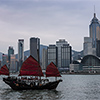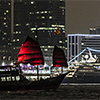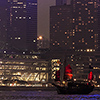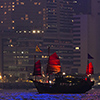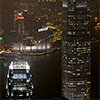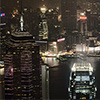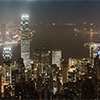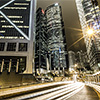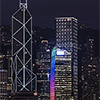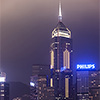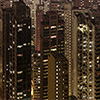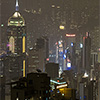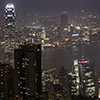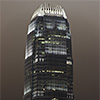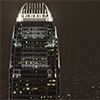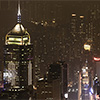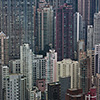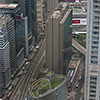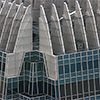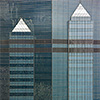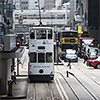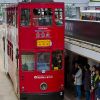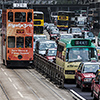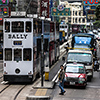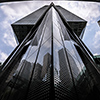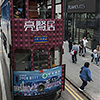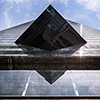Asia wrapped in Glass and Steel – Hong Kong
Even after having returned to the People’s Republic of China, former British crown colony Hong Kong still remains to be one of Asia’s most important centres; and not only in financial terms. Independent from sailing under the free-market or communist flag Hong Kong experienced a quite apparent boom which can’t be ignored when strolling along the seaside promenade along Victoria Harbour. Despite being surrounded by turbo capitalism flexing its glass & steel muscles, many things that kept its Asian authenticity can be spotted among the flickering lights of an ocean of illuminated advertisings. First and foremost this authenticity is emerging from all things called freshness, steam and seafood, in short: Hong Kong’s amazing Cantonese cuisine.
Only a few years ago a flight to Hong Kong was still only something for the strong-hearted. Landing a Jumbo Jet is everything but mere child’s play and approaching Hong Kong’s Kai Tak airport was always the Champions League for pilots as the one or other landing failed after an airplane poked its nose through the curtain of concrete skyscrapers. Specifically built Chek Lap Kok airport put an end to that era of exciting Hong Kong approaches. Within 10 years only the new airport grew to become a very important hub in Asia’s flight network, as from there half of the world population can be reached within a flight time of 5 hours only; needless to say that for Asia travellers Chek Lap Kok logically became a main gateway to cross into China and Hong Kong.
If there is enough time left, then taking the A21 bus to get to the city centre is more interesting than the airport trains. In terms of busses one of Hong Kong’s most magic phrase could be “exact fare please!”, since when paying at the driver you won’t get any change back unless you haven’t paid the exact fare. Hence after having left the arrival hall with usually ATM-caused big money in the pockets, your first walk should lead you to the ticket offices being located at the head of the bus terminal loop. Depending on traffic and your final stop bus A21 needs about 40-50 minutes to cover the distance from Lantau Island to Kowloon’s main axis Nathan Road. Having reached one of Nathan’s southern stops and when leaving the bus you will immediately bump into an army of freelance hotel promoters trying to get you aboard of one of their accommodations.
For many people living in Hong Kong means to manage their everyday life in quite narrow spaces. For example flats are not that large and every kind of space is fully used. Buildings, for example the Chunking Mansion, are literally kissing the neighbouring houses, while being subdivided into several blocks. Each of those blocks has a single character “name”, a particular staircase, sometimes even an own elevator and is a microcosm on its own. The local Rolex branch, selling “original” stuff only of course, is as present as several micro stores specialised in trading cell phone accessories and “homemade” iPhones. Every now and then that shop mixture is interrupted by food stalls.
In Hong Kong you can meet a sheer potpourri of all ethnicities known. Of course you’ll notice the labour seeking Chinese people, but especially in Kowloon things are pretty multi-cultural, so it is no surprise to see a Pakistani and an Indian guy waiting at the same snack stop to become served. They still might look at each other a bit crossly and surely won’t be as equipped with lust for life as the West Africans, who just passed by while taking the Tibetan looking security guy for a ride, but they get along with themselves. Places like the Chunking Mansion are perfect for watching such a world en miniature.
People liking water will surely feel the harbour’s gravitation soon. However, except the regular ferries running on a schedule between Kowloon and Hong Kong Central there is not much happening. If you know for example how lively the Bosporus can be, then HK might be a little disappointing. On the other hand Istanbul is not able to come up with glass and steel residing directly on the edge of the sea, least of all with a 400 meter giant like the Two International Finance Center (IFC).
The famous light show starts everyday at 8pm. For about a quarter of an hour the facades of almost all commercial buildings are flickering wildly around and the green laser located on top of the ICF is ploughing through the cloudy sky. When watching that spectacle from the Kowloon side of the Victoria Harbour the whole scenery is even accompanied by Chinese music. Though, that daily 15 minutes lasting waste of energy does not impress much as it does not really seem to be particularly coordinated…
At 11pm I caught one of the last ferries departing from HK Central to Kowloon. While enjoying the nightly boat ride suddenly a rattling fart bangs against the ship’s metal roof and gets spread echo-like over the whole upper deck; fortunately in terms of noise only. Apparently the sailor ate as well as I did, but apparently a slightly shorter time ago. Continental Europeans answer suchlike situations with gestures varying from amusement to rolling eyes combined with furrowed brows. In China however suchlike is considered more or less as normal. Farting just belongs to the food subject as well as moose-like burps originating from deep inside of the bowels. Fortunately latter one is less noisy, though both digestion products often become a little celebrated. Eating with chopsticks is another subject of food and gets celebrated the same way and also if people even only to stop for eating in a small food stall on the streets, the so called Dai Pai Dongs.
The green or Jasmine Tea given along the meals is also used to heat up and clean the chopsticks. One of the most interesting and authentic spots for having lunch is Soho’s Stanley Street, located in Central Hong Kong at the lower end of the Central-Mid-Levels Escalators. On weekdays there you can witness a likeable spectacle: no second later than noon all seats are taken already and the gas cookers are starting to run at maximum. The chefs are chopping, flavouring, snipping and deep-frying come hell or high water since the suits and white-collars working in the surrounding office buildings are pretty hungry.
For people who are eating not only to fight hunger Hong Kong will be an ideal “you are what you eat” venue since for many local people bringing solely fresh ingredients into action is an affair of the heart. Every day anew this quality definition gets maintained, for example at Graham Street (a cross-road of Stanley Street) where fresh fish and crisp vegetables are nearly lunging at you. One of the marketers is proudly saying: “In Japan everything is deep-frozen, but here in Hong Kong everything is fresh.”
A through and through outstanding delicacy is “grouper in spiced salt”, that comes served with fresh and aromatic rice plus some slightly deep-fried green chillies and a Tsing Tao beer – in short: a full meal and culinary firework for less than 6 Euros. Considering the abundance of food I caught myself devouring up and down the menu. One dish made me stop and asking for its name. Wearing rubber boots the old granny appears more like a gardener but not a cook. Looking at me she holds on for a moment and only lets an answering “Meeeeeow” noise slip through the two incisors remaining in her mouth while additionally break necking an imaginary kitty cat. A sudden “Well, for a cat it doesn’t taste too bad…” thought crossed my cerebrum, while my cerebellum already had given a command to my chopstick accessing fingers to continue eating. The granny answered with a waggish grin, as she didn’t make it to get the stranger out of his shell using well-known clichés ;-)
What baguette is for the Parisians is Dim Sum for people living in Hong Kong. Chinese are enjoying it as breakfast or early lunch, thus it is served until late in the morning. Heart of the Dim Sum tradition is the homonymous wooden steam pot and the communication happening when eating. In terms of meat people who have chosen Dim Sum as breakfast will be put through the mangle, as pork and shrimps are major ingredients and in particular the pork versions of Dim Sum come as moments of truth as they are everything but healthy and balanced nutrition. Also you should be resistant and able to take onions and coriander already in the morning as those two will surely participate when trying Dim Sum. Most of them are dumplings filled with different meats and spices, but also you can find miniature spring roles on the menu as well as deep-fried super thing omelette. The whole meal comes pretty cheap as rarely it costs more than 40 HK$ and often Jasmine tea is served as much as your bladder is able to take.
To take the plunge into a proper, authentic but also inexpensive Dim Sum experience I recommend the Mu Dan Ting restaurant, located in Hankow Road 28, 2nd floor of Pacific Centre in Kowloon. By the way, beckoning for a waitress is kind of common in Hong Kong as eye contact often works only once in a blue moon to place an order or get the bill. Another thing that people from Hong Kong are having a crush on is air conditioning. Even if it’s early spring, that thing is running at full throttle. On the one hand it might help to cool down the nuclearly hot Jasmine tea, but on the other side a jacket becomes a companion essential for survival. Entering a restaurant but seeing everybody sitting almost fully dressed is quite a strange scenery that is only interrupted by the one or other rutting call like burp, when a Chinese is aerating his bowels.
The smaller hostels are wonderfully authentic and also very hospitable, for example Simon’s Guangdong Guest House. However, tall people will get a fundamental problem when staying there since already people with an average European height of 1.75 meters are considered as tall by Asians means. At the latest that is noticeable when going to bed and your body hits both bed ends. Spending the following night literally screwed and sleeping like clamped in a vice is as sure as death and taxes.
Another must-see attraction is the nightly panoramic view over Hong Kong’s glass and steel giants from Victoria Peak, in short The Peak. To take full advantage a multi-story observation deck has been specifically built on the ridge overlooking Soho. It is also the terminus for the steep Peak Tram, which can be reached by taking bus 15C that depart near Star Ferry pier. Having arrived the upper platform of the observation deck you’ll bump into a mixed crowd of Japanese, Germans, Brits, Russians, Indians and of course Chinese people. Often there’s only on thing clouding clear views: low clouds involving drizzle and fog. The 400 meters high IFC tower is literally scraping the sky and touching the water vapour cumulated in heaven, which is absorbing the red-mauve shine of thousands of city lights. The funny thing about The Peak’s name is: it is not a peak. The actual hilltop is even located higher, if not to say 500 meters above where The Peak platform was built. The platform itself is nothing but a tourist trap and mall residing on the ridge between Victoria Peak and Aberdeen hilltop.
The Peak is not the only possibility to have an interesting outlook on the city. The Bank of China as well as the huge ICF Tower are having an observation deck being open to the public. Unfortunately it is not the roof, but in both cases a floor from where you can have a look at Hong Kong from above. Photographically ambitious people won’t find their heaven though as floors are always surrounded by hundreds of “nice” mirroring windows. However the perspectives are definitely worth to be seen. The only hurdle that has to be taken is to have an ID card or passport with you, since without you won’t get a visitor’s pass.
In particular Hong Kong Central is veined with hundreds of asphalt lifelines. A ride with through the urban canyons is most intensive when using the tram. Des Voeux Road is a hot spot for railcars and its rail tracks make you almost stumble when crossing the street. At first glance the tram appears as thin as a chocolate bar, but offers surprisingly much space. And also here the magic phrase is “exact fare please!”

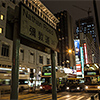
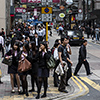
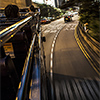
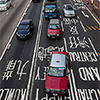
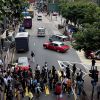
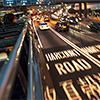
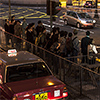
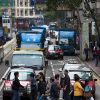
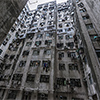
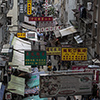
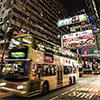
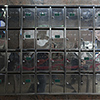
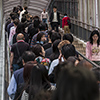
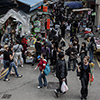
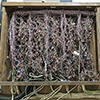
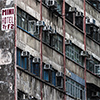
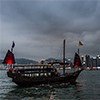
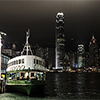
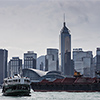
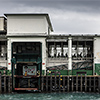
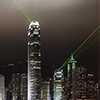
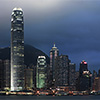
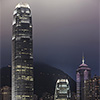
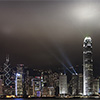
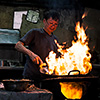
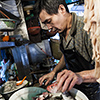
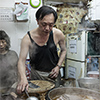
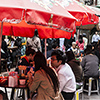
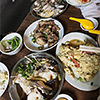
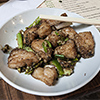
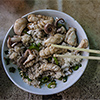
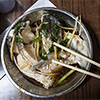
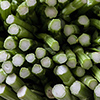
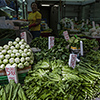
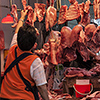
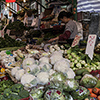
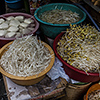
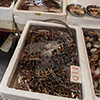
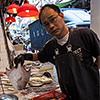
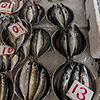
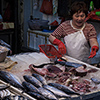
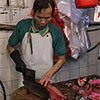
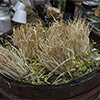
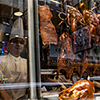
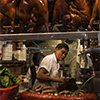
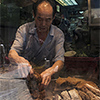
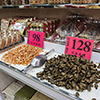
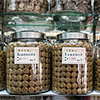
![[Dim Sum] Steamed shrimp meat Hong Kong](https://www.xflow.eu/wp-content/thumb-cache/d7ff5e3329107f5b517ffd91b964129f.jpg)
![[Dim Sum] Steamed pork with apple chunks, onions and fresh coriander Hong Kong](https://www.xflow.eu/wp-content/thumb-cache/e217b3fb3c16e4257ecfa2e6acbe97b2.jpg)
![[Dim Sum] Steamed pork with scallions and different sorts of pepper Hong Kong](https://www.xflow.eu/wp-content/thumb-cache/95db66b09dac3bcb987e60c6e42ce00b.jpg)
